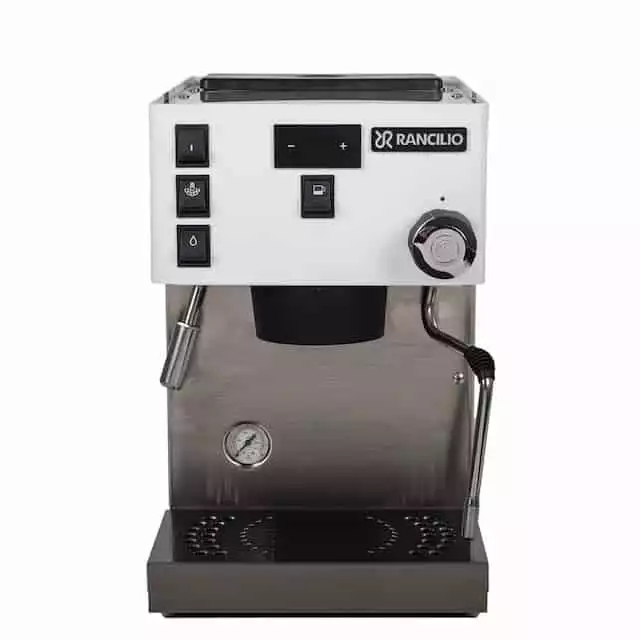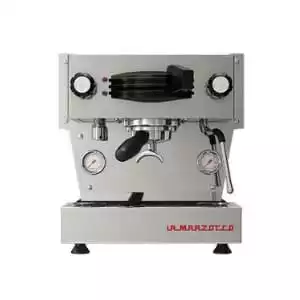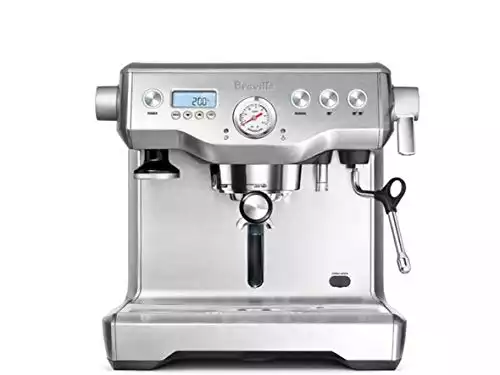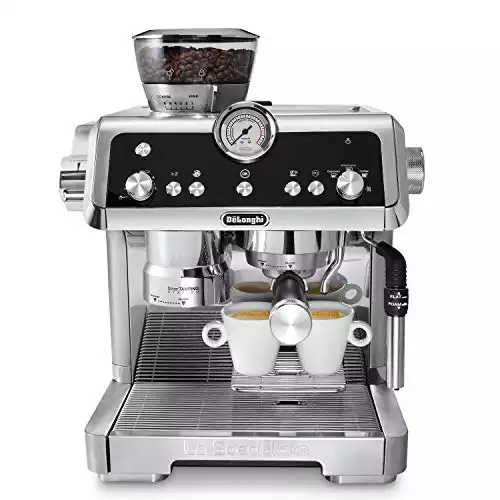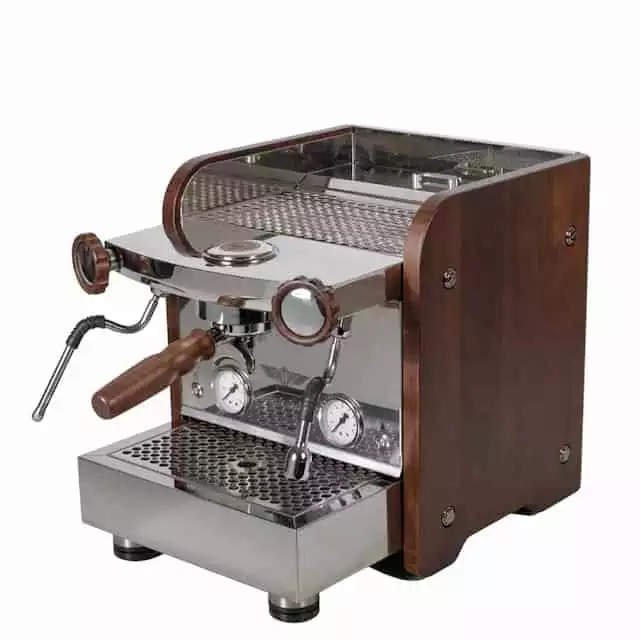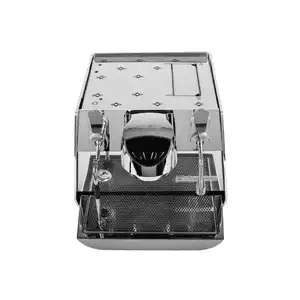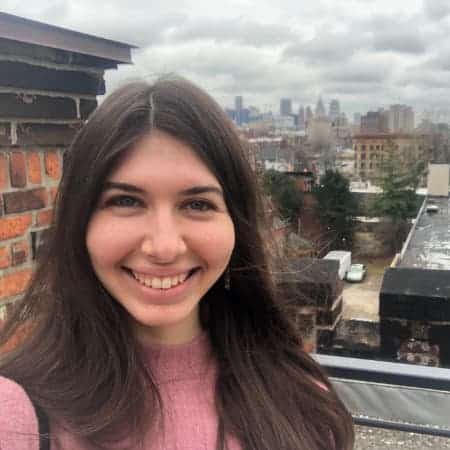Best Dual Boiler Espresso Machine 2024
Everyone wants the best espresso, but do you really need to invest in a fancy machine to get it?
A dual boiler espresso machine is not like other equipment with long names and longer price tags. This kind of espresso machine really does make the difference in your cup of coffee.
Below we look at the best options for a dual boiler espresso machine out there and why you want to consider getting one of these bad boys in the first place.
The ex-barista in me has just started to drool!
Top Dual Boiler Espresso Makers 2024 Summary
Why Is A Dual Boiler Espresso Machine Better?
A dual boiler espresso machine is your best bet for getting the best espresso at home.
Having a dedicated boiler for brewing as well as for steaming means better power, more consistent temperature, and a steadier pressure for steaming milk and pulling shots. Which means your coffee is that much better.
Double boiler machines are sophisticated equipment that are well-made, powerful, and are more likely to come with other great features that serve to make your coffee even better, like pre-infusion and PID temperature control.
Although not cheap, double boilers are the way to go if you can swing it.
The 6 Best Dual Boiler Espresso Machines 2024
1. Rancillio Pro X
“Pro” is the key word with the Rancillio Pro X. espresso machine is a prosumer-quality tool that’s perfect for the serious home barista.
- Dual boiler + PID
- Rapid heat time
- Powerful steam wand
PROS (+)
- PID temperature control for both boilers
- Pre-infusion feature
- Makes commercial quality microfoam
CONS (-)
- Needs frequent descaling
- Can’t refill water tank easily
The Pro X is the upgrade of an already solid espresso machine. It’s Rancillio’s newest espresso machine and the first to have a dual boiler and matching dual PID temperature control.
It also features other upgrades like the “soft” infusion (pre-infusion) feature, brew circuit pressure gauge, and the move to a more standard portafilter size.
That dual PID control is arguably the Pro X’s best feature. Having two boilers is great, but without the dual PID temperature control, there’s a serious limit on the benefits you’ll see from the separate boilers.
A dual boiler allows the machine to rise to two separate temperatures — optimized for brewing and steaming respectively — at once. Not only can a dual boiler espresso machine brew and steam at the same time, it also adjusts better to each use.
PID controllers stabilize the temperatures of the steam and brew boilers separately. Having a dual boiler without dual control isn’t a total waste, but it would severely limit the use of separate boilers in the first place. So the extra tech is necessary here.
You can also program the temperature of each boiler (185-212°F for brewing and 245-275°F for steaming) as well as the pressure for added control over your coffee.
Other controls like pre-infusion, auto wake-up and shut-off, voltage adjustment, descaling, and the ability to empty the boiler, are helpful.
The steam wand is great, too. It’s fully rotational and powerful for a home coffee machine. Consider the Pro X one of your closest options to getting professional-level milk foam on a home espresso machine.
It’s as “commercial quality” as advertised, but it’s darn good. You will be able to make good cappuccino foam and near-flat white level microfoam.
What Could Be Better
The Rancillio Pro X has a built-in water softener, which is great for improving the taste of espresso. But it also means you will need to descale frequently, which is just extra hassle.
Refilling the water tank is also a slight pain. It’s located at the back, which means you have to pull the espresso machine out after every few lattes.
Who Is It for?
In all, the Rancillio Pro X allows you a fair amount of control over your brew while still automating most of the process for you. It’s also not terribly hard to use.
It’s a great in-between, semi-automatic espresso machine, perfect for those who don’t want to take full responsibility or expend too much effort but who care enough to have some say in their espresso.
The Rancillio Pro X is NOT for anyone looking for a fully automatic espresso machine. You’ll get more use out of it if you want to take just a bit of control.
And, although it’s not as expensive as many prosumer dual boiler espresso machines out there, it’s not a budget option, either. You’ll have to be pretty serious to invest in this one.
2. La Marzocco Linea Mini Dual Boiler Espresso Machine
The Linea Mini brings the power of commercial machines to your kitchen in a friendly little size.
- Dual boiler with rapid heat up
- Smart enabled (Bluetooth/WiFi)
- Highly versatile
PROS (+)
- PID control
- Pre-infusion feature
- Brew flow control wheel
CONS (-)
- 10-15 minutes to warm up
- Expensive
The Mini is basically the junior model of the more powerful (and more suited to modest commercial settings) La Marzocco Linea.
The Linea Mini is still pretty darn powerful itself, though. It has PID control and an integrated grouphead to guarantee a more consistent temperature for brewing. It’s easy on the eyes and a lot more powerful than you would expect from a “mini” model.
The Linea Mini offers you a lot of control and power for such a small espresso machine.
It comes with an adjustment wheel that lets you control the brew flow, a one-second pre-infusion feature, and syncs to the La Marzocco app, where it can be turned on/off remotely, go on stand-by, and display stats like the current boiler temperature or shot counter.
Shots are consistently well-pulled, and the steam wand is surprisingly powerful for such a small coffee maker.
All this power and control doesn’t come at the expense of counter space, either. The steaming boiler is actually pretty large, especially for the size of the machine. But perhaps since the integrated grouphead incorporates the powerful brew boiler in a smaller space, the Linea Mini is still petite.
What Could Be Better
As you might guess, a near-commercial-quality dual boiler coffee machine comes at a near-commercial price. You’re getting a lot for the money, but with the Linea Mini, good coffee doesn’t come cheap.
Another downside to the Linea Mini is that it’s slow to warm up, taking as long as 10-15 minutes to reach ideal temperatures. The small size had to cost something.
While overall power during brewing and steaming hasn’t taken a big hit, a little was clearly lost. That lack shows up in the slow wake-up times.
Who Is It For?
The Linea Mini is an almost-manual machine. It’s great for those who want a lot of control and who want to take a more hands-on approach to their espresso, but who don’t want to work the vibratory pumps on their manual espresso maker.
It’s easy to use. You brew on the Linea Mini by switching a paddle on or off and use dials to adjust the steaming and brewing temperatures.
If you want to feel like your machine is manual without working so hard and without introducing more room for human error and inconsistency, the La Marzocco Linea Mini is a great choice.
The Linea Mini is NOT for those who want a very simple, mostly or completely automatic machine or for those who want a better deal on their dual boiler espresso machine.
There are other, equally powerful models that cost less or offer more.
3. Breville BES920XL Dual Boiler Espresso Maker
The Breville BES920XL is a simple but solid espresso machine. It’s sort of the middle ground on this list, standing out for the way it offers a little bit of everything.
PROS (+)
- Automatic pressure control
- PID control
- Pre-infusion feature
CONS (-)
- May develop small drips with time
- Not the best at steaming milk
The Breville BES920XL is the happy medium of dual boiler espresso machines.
It offers some extra controls of the brewing process but is still very simple to use. It doesn’t ask much of you, but is kind enough to offer helpful extras anyway.
The standout feature of the Breville BES920XL is its “over pressure valve,” which limits the maximum pressure to an appropriate level at each stage of brewing. This guarantees consistent pressure without letting your espresso get too bitter.
There are also plenty of perks to this coffee maker. You can program the brew temperature and pre-infusion, which makes for easy control.
There’s an auto setting, a shot clock, and a pressure gauge to help you monitor your success when brewing and help you make manual adjustments (such as tamping more or less hard or playing with the particle size of your ground coffee).
There’s a separate dedicated hot water outlet for Americanos, and the water tank is a convenient top-fill model. It even descales and comes with a two year warranty.
What Could Be Better
This espresso machine SOUNDS like a high-quality espresso maker. You’ll have to look elsewhere if you need a quiet operation.
Another downside to the Breville BES920XL is that it tends to develop a drip in the steam wand and/or water outlet. The drip tray will catch these drips, but it’s frustrating to deal with issues like dripping when you’re investing in a high-quality espresso machine.
Lastly, the BES920XL doesn’t have the best steaming abilities. The wand rotates, but you may struggle to get good microfoam when steaming milk.
Who Is It For?
The Breville BES920XL is a great choice for someone without a ton of experience. This dual boiler espresso machine will handle most of the process for you.
Yet if you develop strong preferences or want to experiment in very safe, simple ways, you can take advantage of the few extra controls offered by the BES920XL.
It’s NOT for someone who wants to determine precise brewing or steaming temperatures and pressures. It’s also not the best choice for anyone who cares about steaming milk.
4. De’Longhi La Specialista Espresso Machine
The De’Longhi La Specialista is ideal for anyone who wants their espresso machine to do all the dirty work for them.
PROS (+)
- Built-in grinder
- Dual PID control
- Automatic machine
CONS (-)
- Not a ton of control
- Not the best microfoam
This fully automatic dual boiler espresso machine wants you to take a load off. Complete with dual PID control and programmed steaming options, this quick-start beauty makes waking up a breeze.
It’s hard not to like a machine that makes pulling an espresso shot about as simple as making drip — with better coffee.
The dual PID control, the “smart tamp” that lets you choose how packed the ground coffee is, and automatic dosing makes it a breeze to use La Specialista. Oh, and don’t forget it has a built-in grinder, saving on mess and hassle!
You can even choose between cappuccino foam or latte microfoam. It’s basically a fully automatic espresso machine.
What Could Be Better
The downside to automatically steaming milk is that it isn’t going to be great.
While La Specialista certainly beats most cheap coffee makers and handheld frothers, it doesn’t compare to many others on this list in terms of steaming abilities. You trade quality for convenience on this one.
Of course, automatic machines also mean a sacrifice of control, which is a disadvantage for some.
Who Is It For?
La Specialista is the best choice for newbies who don’t want to learn how to optimize their shots. La Specialista is designed to do all the work for you, offering truly good espresso with little fuss.
On the flip side, La Specialista is NOT for anyone who wants a little (or a lot) of control over their brew.
5. El Rocio Zarre V2 Espresso Machine
The Zarre V2 from El Rocio is a neat new model dual boiler espresso machine that lets you call the shots. You can control most of the process or take advantage of pre-programmed shot profiles, letting the machine do all the work.
PROS (+)
- Pre-programmed shot profiles
- PID control
- Can brew automatically or semi automatically
CONS (-)
- Not for absolute beginners
- Steam wand isn’t special
The Zarre V2 is a flexible machine. It’s basically an automatic espresso maker that lets you take the reins and treat it like a manual espresso machine whenever you want. It’s whatever you want it to be when you want it to be.
With the Zarre V2, you can have a pretty traditional brewing experience reminiscent of manual espresso machines and their manual pump system. Just turn the knob that’s attached to the internal vibrating rotary pumps to manipulate the pressure and flow as you brew.
At the same time, pre-programmed shot profiles, on/off buttons, and automatic pre-infusion and pressure controls can make this espresso machine practically hands-off. You can use profiles that have already been programmed with the machine or create your own profiles to save on the Zarre V2.
If you want a more consistent pressure, the Zarre V2 will automatically adjust the pressure high and low at the right points during extraction. You won’t have to worry about paddling a switch or turning the knob at the right moment to get the pressure right.
You can experiment until you have your shots perfectly optimized to your tastes, set it as a shot profile, and then never work another day in your life. (For good coffee, that is.)
What Could Be Better
As with many dual boiler espresso machines, the Zarre V2 is so-so in terms of price. It’s not the most expensive out there, and since it’s pretty rare in the amount of flexibility it offers, it’s probably worth it — but only if you have the money in the first place.
The biggest downside, however, is that the Zarre V2 is not ideal for beginners.
Even though it’s not terribly difficult when you get the hang of it, juggling pressure and flow control and toggling between pre-sets is already something more experienced home baristas would likely need to get used to.
The Zarre V2 isn’t automatic enough to be a good one-touch option for a newbie.
Who Is It For?
El Rocio’s Zarre V2 is for the experienced and adventurous coffee lover.
It’s incredibly convenient for that special person, allowing them almost full control over the entire process, plus the ability to stumble out of bed and have coffee brewing with just a couple of buttons.
You have room to figure out what you like with the Zarre V2.
It’s NOT for anyone who’s new to making espresso at home and it’s definitely not for anyone who wants espresso with a single touch. The Zarre V2 doesn’t make sense for someone who doesn’t want to be involved (even if that just means telling the espresso machine what to do).
You won’t get as much out of it if you don’t understand what all the presets and terms mean.
6. Victoria Arduino Eagle One Prima Espresso Machine
Last but not least, the Eagle One Prima is an entirely digital one-group espresso machine perfect for serious home and light commercial use.
PROS (+)
- Suitable for light commercial use
- 100% digital
- E1 group head
CONS (-)
- Few physical controls
- Need app to use
The Eagle One is completely digital and “smart” and can be operated from the accompanying app. You can control steam and hot water, set the temperature, and explore recipes.
You can choose the volume you brew or use the continuous run option. It also has a cool-to-the-touch steam wand.
The Eagle One Prima has an insulated, instant heating “NEO engine,” which conserves heat energy and saves energy.
What Could Be Better
The Eagle One Prima is so digital you’ll either love it or hate it.
The machine itself has a “ghost display,” showing only shot times and codes. Boiler temperatures, pump pressures, the rest of the shot information, and anything else can only be seen on the app.
Many espresso makers are app-paired and friendly these days, but most don’t require you to download and keep an app on your phone just to make coffee.
Who Is It For?
The Eagle One Prima is great for easy, automated light commercial use or serious home use.
It’s NOT for those who want a ton of control over their brew, nor anyone who doesn’t want to rely on an app.
Dual Boiler Espresso Machines Buying Guide
What Is A Dual Boiler Espresso Machine?
A dual boiler espresso machine is an espresso maker that has separate boilers for brewing coffee and steaming milk.
Brewing and steaming should happen at different temperatures. So having two separate boilers means you can have hot water ready at both temperatures at the same time.
With a dual boiler espresso machine you can brew espresso and steam milk at the same time. Plus, the machine is often ready for either use faster and can often maintain each temperature better.
Dual VS Single Boiler
There are two types of espresso machine by boiler type: single or double.
Single boiler, or heat exchange (HX), espresso machines have just one boiler that will heat up for both brewing coffee and steaming milk.
Some of the heated water from the boiler is exchanged through tubes in the machine so it can cool ever so slightly before reaching the grouphead – where espresso shots are pulled. (Espresso is brewed at slightly lower temperatures than milk is steamed.)
The brew water comes from the steam water.
You can usually do just one function at a time with a heat exchanger. You may have to wait a couple minutes when switching between one function and the other.
Dual boiler espresso machines, as we said above, have separate steam and brew boilers. Hot water is often ready faster to pull shots, and a dual boiler espresso machine tends to have better steam power, too. You can usually pull shots and steam milk at the same time.
Dual boilers usually have PID temperature control, which stabilizes the temperature to ensure water stays at the precise temperature needed to brew shots well. The brew boiler will constantly adjust to keep the temperatures right.
Some dual boilers even have dual PID controllers, one each for the steaming and brewing boilers. That translates into higher quality coffee, since both boilers stay at the ideal temperature.
A single boiler espresso machine has less precise temperature control since the same boiler has to heat water for two different functions requiring two different temperatures.
The best temperatures come at a cost, though. A dual boiler machine is more expensive.
How Boilers Function
The job of a boiler on an espresso machine is simple: it heats water to the ideal temperature(s) needed to make coffee.
In a single boiler or heat exchanger machine, the steam boiler works up to the ideal water temperature for steaming. Some of that water is then “exchanged” through inner tubes until it reaches the grouphead – where espresso shots are brewed.
The water temperature will naturally decrease a little, reaching the right temperature (more or less) for brewing.
In a dual boiler espresso machine, the steam boiler heats water to ideal steaming temperature(s), while the separate brew boiler heats water to the ideal brew temperature(s). There is always hot water ready (unless the machine is powered off or on standby).
As we said above, many dual boiler espresso machines also have PID temperature control. In this case a temperature gauge is attached to the brew boiler – and maybe the steam boiler, too. If the temperature lowers too much, the boiler responds and heats back to the right point.
Machine Pros
Dual boiler espresso machines have a major advantage:
They make better coffee.
Separate boilers = separate tools for each process = each process is done REALLY well.
Espresso shots are ALWAYS pulled at the best temperature(s) with a dual boiler espresso machine. Especially since these machines usually have PID control, too. These machines are a lot more consistent.
Dual boilers also tend to have better steam power, maybe because the steam boiler isn’t overworked, playing double duty on heating water. That means a better steam wand, better microfoam, and your best chance of getting milk that’s good enough for latte art.
Separate boilers make coffee faster. You don’t have to wait for the boiler to adjust to one process or the other. Both boilers are at the ready pretty quickly and can work simultaneously.
Since dual espresso machines are higher-level machines, the parts are usually well made and make a powerful machine. They’re more likely to offer you more control of the process. You may even be able to adjust the temperature and pressure for brewing, steaming, or both.
In short, dual boiler machines are just GOOD espresso makers.
Machine Cons
The biggest downside to an incredibly powerful espresso maker is the price tag.
Two boilers are basically a guarantee of getting really good coffee. But only if you’re willing to pay for premium coffee.
If you hunt around, you can find smaller machines that are less flashy for better prices. If you’re on a budget, consider a single boiler espresso machine.
Picking Your Dual Boiler Espresso Maker
Ease Of Use
Double boiler machines are usually easy to use. They tend to warm up faster, brew and steam simultaneously, and offer consistent results with less effort.
Look for features like one-touch pre-infusion, automatic wake-up/shut-off, pressure gauges, and digital temperature control.
Digital interfaces can be easy to use, but if you have to toggle the same button(s) over and over to access a menu, digital controls can be more difficult to learn and operate.
Most importantly, you’ll need to decide if you want a semi-automatic or automatic espresso machine.
Fully automatic machines are the easiest to use since they handle for you from the point you put ground coffee in the portafilter. (Sometimes sooner.)
For more control over your steam and brew temperature/pressure, look for a semi-automatic machine that offers some control with an easy-to-use interface.
Make sure your machine comes with basic tools like a single and double shot basket, backflush filter, cleaning materials, and milk pitcher.
Milk Frothing & Drink Making
When you’re evaluating the steam wand on a coffee machine, there are two main things to consider:
- Overall steam power
- Whether the steam wand is fully rotational
A decent amount of power/pressure and the ability to reach the right temperature for steaming milk is key to getting nicely textured milk. With a double boiler machine, you have a fair amount of power in the first place.
A steam wand that is fully rotational can move in a full circle and can be lifted and lowered. That allows you to pull it out to a good angle for steaming and move the pitcher around it more easily, helping you get better foam.
If making milk-based drinks is important to you, it’s important to read reviews. But user error and variation in abilities will be high in this area, so take each one with a grain of salt.
PID
Most dual boilers have PID control for brewing, and it’s something you don’t want to pass on.
You’re already investing in these fancy machines. Missing out on an even more consistent shot when you’re spending a pretty penny and when so much has already been put into making a sophisticated machine with two boilers is just silly.
It’s also worth looking for machines with dual PID temperature controls and/or pressure controls, although that’s less common. These features offer more say so you can brew your ideal cup.
The Investment
Dual boiler machines aren’t cheap, but they’re good.
If you can afford it, this tier of espresso maker is going to be your best bet for really great espresso at home. It’s often your best bet for better milk steaming, too.
A dual boiler espresso machine should last several years. They are usually well-made of high-quality materials. Many brands that manufacture them offer warranties and/or replacement parts as well.
So the investment is usually a sound one, especially if you check reviews.
But if you can’t afford $2,000-6,000 for a home espresso machine, then that’s that. Sometimes it isn’t much cheaper than going to a cafe.
Buying a dual boiler espresso machine is a matter of wanting great coffee without having to leave the house when price isn’t a major concern.
If you can’t swing it, you’re better off looking for simple heat exchange espresso makers. Some will surprise you with their abilities.
The Final Verdict: Best Dual Boiler Espresso Machines
In terms of overall quality, the Rancillio Pro X is a dual boiler espresso machine that can’t be beat. It’s powerful, consistent, and offers a good balance of control and automation.
- Dual boiler + PID
- Rapid heat time
- Powerful steam wand
But if you want more room to explore, try the Zarre V2, the choose-your-own-adventure of espresso machines.
And if you want a home barista machine with no fuss on your end, La Specialista is the machine for you.

